基于Si4438、EFR32MG、RZ/A1主控器件的远距离无线通讯充电桩控制板解决方案
 443
443
 拍明
拍明
近几年,随着电动汽车保有量的上升,对充电桩的需求也在逐年增加。传统充电桩控制板一般采用RS-485或CAN总线的通讯方式,采用这种方式的充电桩在投放过程中需要大量布线,大大增加了建设成本与维护成本。为此推出了。

在设计无线充电桩控制板解决方案时,考虑到充电桩的管理系统是采用集中管理的方式,即一个主站控制多台充电桩的管理模块。在无线组网上只需要一主多从的网络控制就可以了,所以无线充电桩控制方案中选择了目前在国内使用最为广泛的SI4438 SUB-G无线收发芯片。SI4438是Silicon Labs公司针对中国市场推出的一款SUB-G无线收发芯片。SI4438芯片内部集成PA,发射功率可达20dBm,接收灵敏度可达-124dBm,通讯距离可以达到2公里以上。可以轻松地实现一主多从的网络模式。
【Si4438】
HIGH-PERFORMANCE, LOW-CURRENT TRANSCEIVER
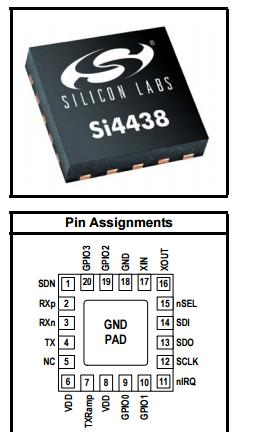
Features
> Frequency range = 425–525 MHz
> Receive sensitivity = –124 dBm
> Modulation
》(G)FSK
》OOK
> Max output power
》+20 dBm
> Low active power consumption
》14 mA RX
> Ultra low current powerdown modes
》30 nA shutdown, 50 nA standby
> Data rate = 100 bps to 500 kbps
> Fast wake and hop times
> Power supply = 1.8 to 3.6 V
> Excellent selectivity performance
》58 dB adjacent channel
》75 dB blocking at 1 MHz
> Antenna diversity and T/R switch control
> Highly configurable packet handler
> TX and RX 64 byte FIFOs
> Auto frequency control (AFC)
> Automatic gain control (AGC)
> Low BOM
> Low battery detector
> Temperature sensor
> 20-Pin QFN package
> IEEE 802.15.4g ready
> China regulatory
Applications
> China smart meters
Description
Silicon Laboratories' Si4438 is a high-performance, low-currenttransceivers covering the sub-GHz frequency bands from 425 to525 MHz. The Si4438 is targeted at the Chinese smart meter market andis especially suited for electric meters. This device is footprint- andpin-compatible with the Si446x radios, which provide industry-leadingperformance for worldwide sub-GHz applications. The radios are part ofthe EZRadioPRO® family, which includes a complete line of transmitters,receivers, and transceivers covering a wide range of applications. Allparts offer outstanding sensitivity of –124 dBm while achieving extremelylow active and standby current consumption. The 58 dB adjacent channelselectivity with 12.5 kHz channel spacing ensures robust receiveoperation in harsh RF conditions. The Si4438 offers exceptional outputpower of up to +20 dBm with outstanding TX efficiency. The high outputpower and sensitivity results in an industry-leading link budget of 144 dBallowing extended ranges and highly robust communication links.
Functional Block Diagram
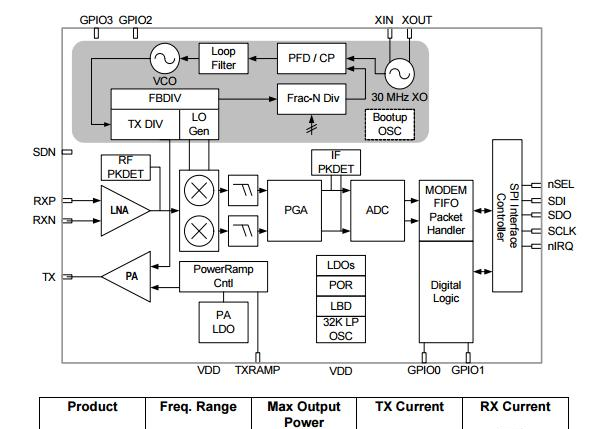
对于一些需要更复杂的网络方案,推荐采用Silicon Labs的EFR32MG这款2.4G的多协议的无线SoC。EFR32MG支持ZIGBEE/THREAD协议,支持自组网,提供有稳健、可靠的ZIGBEE,THREAD协议栈。芯片内部集成硬件加密引擎,可保证无线数据的安全可靠。芯片的发射功率可达19.5dBm,可实现远距离的无线通讯。
【EFR32MG】
EFR32MG 2.4 GHz 19.5 dBm Radio Board BRD4151A Reference Manual
The EFR32MG family of Wireless SoCs deliver a high performance, low energy wireless solution integrated into a small form factor package.
By combining a high performance 2.4 GHz RF transceiver with an energy efficient 32-bitMCU, the family provides designers the ultimate in flexibility with a family of pin-compatible devices that scale from 128/256 kB of flash and 16/32 kB of RAM. The ultra-low power operating modes and fast wake-up times of the Silicon Labs energy friendly 32- bit MCUs, combined with the low transmit and receive power consumption of the 2.4 GHz radio, result in a solution optimized for battery powered applications.
To develop and/or evaluate the EFR32 Mighty Gecko, the EFR32MG Radio Board can be connected to the Wireless Starter Kit Mainboard to get access to display, buttons and additional features from Expansion Boards.
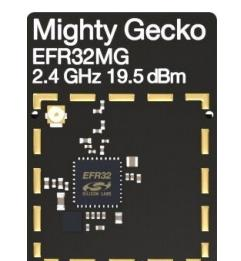
RADIO BOARD FEATURES
• Wireless SoC:EFR32MG1P232F256GM48
• CPU core: ARM Cortex-M4 with FPU
• Flash memory: 256 kB
• RAM: 32 kB
• Operation frequency: 2.4 GHz
• Transmit power: 19.5 dBm
• Integrated PCB antenna, UFL connector(optional).
• Crystals for LFXO and HFXO: 32.768 kHzand 38.4 MHz.
1. Introduction
The EFR32 Mighty Gecko Radio Boards provide a development platform (together with the Wireless Starter Kit Mainboard) for theSilicon Labs EFR32 Mighty Gecko Wireless System on Chips and serve as reference designs for the matching network of the RF interface.
The BRD4151A Radio Board is designed to operate in the 2400-2483.5 MHz band with the RF matching network optimized to operatewith 19.5 dBm output power.
To develop and/or evaluate the EFR32 Mighty Gecko, the BRD4151A Radio Board can be connected to the Wireless Starter Kit Mainboardto get access to display, buttons and additional features from Expansion Boards and also to evaluate the performance of the RFinterface.
2. Radio Board Connector
2.1 Introduction
The board-to-board connector scheme allows access to all EFR32MG1 GPIO pins as well as the RESETn signal. For more information on the functions of the available pin functions, see the EFR32MG1 data sheet.
2.2 Radio Board Connector Pin Associations
The figure below shows the pin mapping on the connector to the radio pins and their function on the Wireless Starter Kit Mainboard.
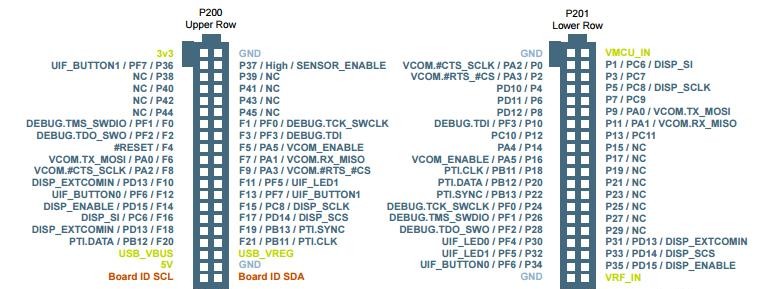
3. Radio Board Block Summary
3.1 Introduction
This section gives a short introduction to the blocks of the BRD4151A Radio Board.
3.2 Radio Board Block Diagram
The block diagram of the EFR32MG Radio Board is shown in the figure below.
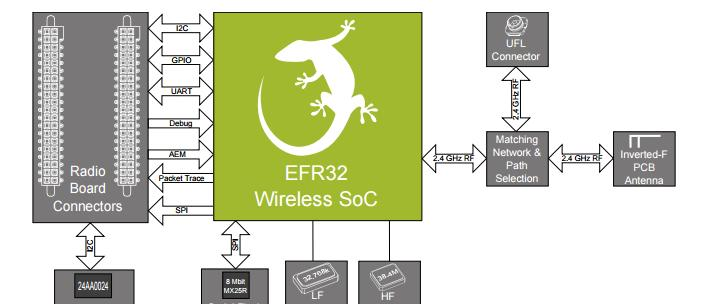
3.3 Radio Board Block Description
3.3.1 Wireless MCU
The BRD4151A EFR32 Mighty Gecko Radio Board incorporates an EFR32MG1P232F256GM48 Wireless System on Chip featuring32-bit Cortex-M4 with FPU core, 256 kB of flash memory and 32 kB of RAM and a 2.4 GHz band transceiver with output power up to19.5 dBm. For additional information on the EFR32MG1P232F256GM48, refer to the EFR32MG1 Data Sheet.
3.3.2 LF Crystal Oscillator (LFXO)
The BRD4151A Radio Board has a 32.768 kHz crystal mounted.
3.3.3 HF Crystal Oscillator (HFXO)
The BRD4151A Radio Board has a 38.4 MHz crystal mounted.
3.3.4 Matching Network for 2.4 GHz
The BRD4151A Radio Board incorporates a 2.4 GHz matching network which connects the 2.4 GHz TRX pin of the EFR32MG1 to the one on-board printed Inverted-F antenna. The component values were optimized for the 2.4 GHz band RF performace and current consumptionwith 19.5 dBm output power.
For detailed description of the matching network, see Chapter 4.2.1 Description of the 2.4 GHz RF Matching.
3.3.5 Inverted-F Antenna
The BRD4151A Radio Board includes a printed Inverted-F antenna (IFA) tuned to have close to 50 Ohm impedance at the 2.4 GHzband.
For detailed description of the antenna see Chapter 4.5 Inverted-F Antenna.
3.3.6 UFL Connector
To be able to perform conducted measurements, Silicon Labs added an UFL connector to the Radio Board. The connector allows anexternal 50 Ohm cable or antenna to be connected during design verification or testing.Note: By default the output of the matching network is connected to the printed Inverted-F antenna by a series component. It can beconnected to the UFL connector as well through a series 0 Ohm resistor which is not mounted by default. For conducted measurementsthrough the UFL connector the series component to the antenna should be removed and the 0 Ohm resistor should be mounted (seeChapter 4.2 Schematic of the RF Matching Network for further details).
3.3.7 Radio Board Connectors
Two dual-row, 0.05” pitch polarized connectors make up the EFR32MG Radio Board interface to the Wireless Starter Kit Mainboard.
For more information on the pin mapping between the EFR32MG1P232F256GM48 and
the Radio Board Connector, refer to Chapter 2.2 Radio Board Connector Pin
Associations.
转换效率高达99%的平板变压器
在推荐的方案中,另外一个亮点就是在变压器的选择。传统的变压器存在体积大、转换效率低的问题,导致很难将产品的体积做小。Standex-Meder公司的PG20平板变压器,体积小,低匝数低损耗,低漏感,转换效率高达99%。而且这是一款可按需定制的产品,可以满足不同设计需求。
电源系统的无线收发和短路保护设计
在电源系统的设计上,考虑到无线收发的瞬间需要较大的电流,所以选择Ricoh公司的R1245x/R1240x系列的DC/DC转换器。这一系列的DC/DC可支持1A以上的输出电流,最大可支持14A的电流,完全可以满足控制板的供电需求。同时这一系列的DC/DC满足AEC-Q100标准,有DFN/SOT/HSOP等多种封装可供选择。
电源的保护采用Littelfuse公司的可自恢复型的PTC,可保证电路板在接错线等瞬时短路的保护。这款PTC提供有贴片,插件等形式,方便生产、加工。
充电桩的电路控制设计
控制板的主控MCU我们推荐Renesas公司的RZ/A1系列的32位MCU。这款MCU采用CORTEX-A9内核,工作主频可达400MHz,可运行UCOS等操作系统,可简化充电桩的设计。芯片内集成有10MB容量的RAM,并支持2D图像采集和处理。同时芯片内集成有16路的PWM,非常适合充电电路的控制。电量计量的电流传感器,我们推荐采用Melexis公司的MLX91210传感器。这款电流传感器体积小,只有SO8封装,可以节省充电桩的PCB设计空间。
【RZ/A1H】
RZ/A1H is the premium full-featured part in the RZ/A1 family with an Arm® Cortex®-A9 core running at 400MHz and 10MB of on-chip SRAM to support the largest frame-buffers on-chip.
With 10MB on-chip SRAM, the RZ/A1H supports up to 2 Displays with WXGA (1280x800) resolution without the need for external memory. RZ/A1H enables very compact embedded designs without the need to worry about memory procurement and memory EOL. With RZ/A1H, you can design your embedded system like an MCU and get the performance of a 400MHz Arm® Cortex®-A9 MPU. Enabled for support with Linux, RTOS or Bare-metal, this is the ideal device for designing Intelligent IoT End Point devices with compactness and high performance. Supported in QFP and BGA packages with different sizes to support board layout flexibility and with SDRAM interface to expand up to 128MB of external memory.
Key Features:
| ITEM | RZ/A1H | |
|---|---|---|
Part name/use/ package | 256 pin | R7S721000VLFP |
| Car Accessory | ||
| 256-pinQFP (28mm×28mm) 0.4mm pitch | ||
| R7S721000VCFP | ||
| Industry usage etc. | ||
| 256-pinQFP (28mm×28mm) 0.4mm pitch | ||
| R7S721000VCBG | ||
| Industry usage etc. | ||
| 256-pinBGA (11mm×11mm) 0.5mm pitch | ||
| 324 pin | R7S721001VLBG | |
| Car Accessory | ||
| 324-pinBGA (19mm×19mm) 0.8mm pitch | ||
| R7S721001VCBG | ||
| Industry usage etc. | ||
| 324-pinBGA (19mm×19mm) 0.8mm pitch | ||
Power supply voltage | 3.3V/1.18V | |
Maximum operating frequency | 400MHz | |
CPU core | Arm®Cortex®-A9 (with Jazelle and NEON) | |
On-chip RAM | Large-capacity memory: 10 MB | |
| (For video display/work area; 128 KB are shared with data retention) | ||
Cache memory | Primary cache memory: 64 KB (separated 32K instruction/32K data, TLB128 entry) Secondary cache memory: 128 KB (with CoreLink™ Level 2 Cache Controller L2C-310) | |
| External memory | Bus clock: up to 66.67 MHz | |
| Direct connection to SRAM, byte select SRAM, SDRAM, and burst ROM (clock synchronous/clock asynchronous) using bus state controller. Address/data multiplexer I/O (MPX) interface supported. | ||
Address space: 64 MB × 6 | ||
Data bus width: external 8/16/32 bits | ||
Graphics functions | OpenVG1.1 2D graphics accelerator | |
| Video display controller (2 channels of video input and 2 channels of panel output, of which 1 channel supports LVDS) | ||
| Video decoder × 2 channels (analog composite direct input is possible) | ||
| Distortion correction engine × 2 channels (requires nondisclosure agreement) | ||
| Distortion correction engine for display (requires nondisclosure agreement) | ||
| Display out compare unit | ||
| JPEG codec unit | ||
| Capture engine unit (CMOS camera interface) | ||
| Pixel format converter × 2 channels | ||
Audio functions | SCUX (with built-in asynchronous sampling rate conversion, digital volume & mute, and mixer function) | |
| Serial sound interface × 6 channels | ||
| Renesas SPDIF interface | ||
| Sound generator × 4 channels | ||
| CD-ROM decoder | ||
Timer functions | Multifunction 16-bit timer (MTU2) × 5 channels | |
| 32-bit OS timer × 2 channels | ||
| Motor control PWM timer × 8 channels | ||
| Watchdog timer | ||
| Real-time clock | ||
Connectivity functions | USB 2.0 host/function module × 2 channels (host or functon selectable) | |
| NAND flash interface | ||
| SD host interface × 2 channels (must obtain SD card license) | ||
| MMC host interface | ||
| Ethernet controller (10 Mbps/100 Mbps transfer, IEEE802.3 PHY interface MII) | ||
| Ethernet AVB (IEEE802.1 Audio/Video Bridging) controller (requires nondisclosure agreement) | ||
| SPI multi I/O bus controller × 2 channels (up to 2 serial flash memory connectable to 1 channel, direct execution from CPU supported) | ||
| Serial communication interface with 16-stage FIFO (SCIF) × 8 channels (asynchronous and clock synchronous serial communication possible) | ||
| Serial communication interface × 2 channels (smart card interface, IrDA 1.0) | ||
| Renesas serial peripheral interface × 5 channels | ||
| I2C bus interface × 4 channels | ||
| Media Local Bus (MediaLB Ver2.0) | ||
| Controller area network (CAN) × 5 channels | ||
| Local interconnect network interface (LIN) × 2 channels | ||
System analog functions | Clock pulse generator (CPG): built-in PLL, maximum 32 times multiplication, built-in SSCG circuit | |
| Direct memory access controller × 16 channels | ||
| Interrupt controller (with Arm®Generic Interrupt Controller [PL390]) | ||
| A/D converter (12-bit resolution) × 8 channels | ||
| Debugging interface | ||
| CoreSight™ architecture | ||
| JTAG standard pin layout | ||
Optional function | Encryption engine (requires nondisclosure agreement) | |
| Boot modes | Boot mode 0: Boot from memory connected to CS0 space (16-bit bus) | |
| Boot mode 1: Boots from memory connected to CS0 space (32-bit bus) | ||
| Boot mode 2: (not defined) | ||
| Boot mode 3: Boot from serial flash memory | ||
| Boot mode 4: Boot from built-in NAND flash memory of SD controller | ||
| Boot mode 5: Boot from built-in NAND flash memory of MMC controller | ||
| Power-down modes | Sleep mode | |
| Software standby mode | ||
| Deep standby mode | ||
| Module standby mode | ||
Pin count /Memory size Lineup:
SRAM
| 10240KB | ● | ● | ● |
|---|---|---|---|
| Pins Package | 256 LFQFP | 256 LFBGA | 324 FBGA |
Block Diagram:
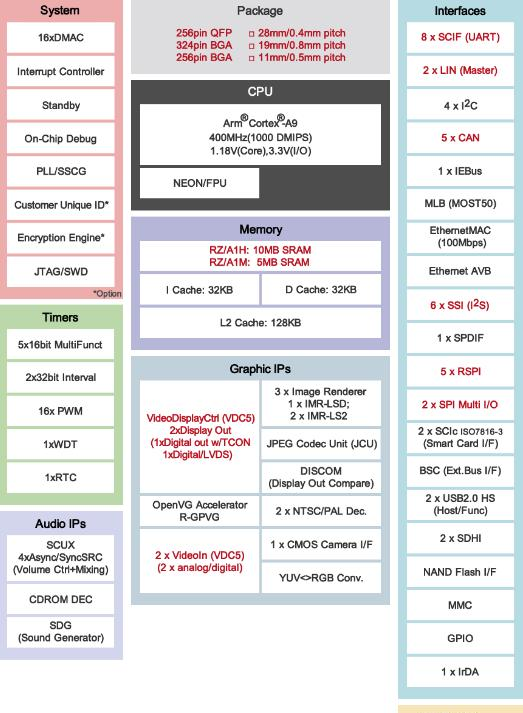
RZ/A1H Block Diagram
*Arm, Cortex, CoreLink, and CoreSight are registered trademarks or trademarks of Arm Limited.
OpenVG is a trademark of the Khronos Group.
CAN (Controller Area Network): An automotive network specification developed by Robert Bosch GmbH of Germany.
LIN (Local Interconnect Network): An automotive network specification established by the LIN Consortium.
MediaLB (Media Local Bus): A registered trademark of SMSC, and an automotive network specification developed by SMSC.
IEBus™ (Inter Equipment Bus) is a trademark of Renesas Electronics Corporation.
All other names of products or services mentioned here are trademarks or registered trademarks of their respective owners.
采用所荐的器件,可以缩短产品的设计周期,提高产品的性能,使产品在市场上更有竞争优势。
相关元件供应
型号:SI4438-C2A-GMR 型号:SILICON LABS
型号:SI4438-B1C-FMR 型号:SILICON LABS
型号:MLX91210KDC-CAS-102-RE 型号:MELEXIS
型号:SI4438-B1C-FM 型号:SILICON LABS
型号:MLX91210KDC-CAS-101-RE 型号:MELEXIS
型号:MLX91210KDF-CAS-101-RE 型号: MELEXIS
充电桩其功能类似于加油站里面的加油机,可以固定在地面或墙壁,安装于公共建筑(公共楼宇、商场、公共停车场等)和居民小区停车场或充电站内,可以根据不同的电压等级为各种型号的电动汽车充电。充电桩的输入端与交流电网直接连接,输出端都装有充电插头用于为电动汽车充电。充电桩一般提供常规充电和快速充电两种充电方式,人们可以使用特定的充电卡在充电桩提供的人机交互操作界面上刷卡使用,进行相应的充电方式、充电时间、费用数据打印等操作,充电桩显示屏能显示充电量、费用、充电时间等数据。
充电桩(栓)能实现计时、计电度、计金额充电,可以作为市民购电终端。同时为提高公共充电桩(栓)的效率和实用性,今后将陆续增加一桩(栓)多充和为电动自行车充电的功能。
作为电网配用电侧的电动汽车充电桩(栓),其结构的特殊性决定了自动化通信系统的特点是被测点多且分散、覆盖面广、通信距离短。并且随着城市的发展,网络拓扑要求具有灵活性和扩展性的结构,因此,电动汽车充电桩(栓)通信方式的选择应考虑如下问题:
(1) 通信的可靠性——通信系统要长期经受恶劣环境和较强的电磁干扰或噪音干扰的考验,并保持通信的畅通。
(2) 建设费用——在满足可靠性的前提下,综合考虑建设费用及长期使用和维护的费用。
(3) 双向通信——不仅能实现信息量的上传,还要实现控制量的下达。
(4) 多业务的数据传输速率——随着以后终端业务量的不断增长,主站到子站、子站到终端之间通信对实现多业务的数据传输速率要求越来越高。
(5) 通信的灵活性和可扩展性——由于充电桩(栓)具有控制点面多、面广和分散的特点,要求采用标准的通信协议,随着“ALL IP”网络技术趋势的发展以及电力运营业务的不断增长,需要考虑基于IP的业务承载,同时要求便于安装施工、调试、运行、维护。
责任编辑:Davia
【免责声明】
1、本文内容、数据、图表等来源于网络引用或其他公开资料,版权归属原作者、原发表出处。若版权所有方对本文的引用持有异议,请联系拍明芯城(marketing@iczoom.com),本方将及时处理。
2、本文的引用仅供读者交流学习使用,不涉及商业目的。
3、本文内容仅代表作者观点,拍明芯城不对内容的准确性、可靠性或完整性提供明示或暗示的保证。读者阅读本文后做出的决定或行为,是基于自主意愿和独立判断做出的,请读者明确相关结果。
4、如需转载本方拥有版权的文章,请联系拍明芯城(marketing@iczoom.com)注明“转载原因”。未经允许私自转载拍明芯城将保留追究其法律责任的权利。
拍明芯城拥有对此声明的最终解释权。




 产品分类
产品分类















 2012- 2022 拍明芯城ICZOOM.com 版权所有 客服热线:400-693-8369 (9:00-18:00)
2012- 2022 拍明芯城ICZOOM.com 版权所有 客服热线:400-693-8369 (9:00-18:00)


